What is Technical SEO?
Technical SEO is the foundation of your website's search engine optimization strategy. It focuses on optimizing the backend structure and performance of your website to improve search engine crawling, indexing, and ranking. By addressing technical elements, you ensure that search engines can easily access, understand, and rank your content, which ultimately leads to better visibility and user experience.
Technical SEO’s Role in an Overall SEO Strategy
Technical SEO is a critical component of a comprehensive SEO strategy. While content and backlinks play significant roles in SEO, without a solid technical foundation, these efforts can fall short. Technical SEO ensures that your site is easy for search engines to crawl and index, which is necessary for ranking well in search results. It also enhances user experience, which can directly impact site engagement and conversions.
Common Technical SEO Activities
Accessibility and Indexing Checks
Ensure that all important pages are accessible to search engines and correctly indexed. This involves reviewing robots.txt files, XML sitemaps, and monitoring Google Search Console for any indexing issues.
Content Management System (CMS) Tasks
Optimize your CMS settings for SEO. This includes setting up proper URL structures, enabling breadcrumbs, and ensuring mobile-friendliness. Proper CMS configuration is crucial for seamless content management and optimization.
Crawling
Regularly check your site’s crawlability. This involves analyzing server logs and using tools like Googlebot to ensure search engines can navigate your site efficiently without being blocked by unnecessary parameters or broken links.
Domain Work and Migrations
If you’re moving domains or restructuring your site, manage migrations carefully to avoid losing search engine rankings. This includes setting up 301 redirects, updating internal links, and notifying search engines of the changes.
Metadata Analysis and Issue Scoping
Audit your metadata, including title tags, meta descriptions, and headers, to ensure they are optimized for target keywords and not duplicated. This step is crucial for improving click-through rates and ensuring content relevance.
Top-Level Site Security
Implement HTTPS to secure your website, as Google prioritizes secure sites in search rankings. Regularly update your SSL certificates and ensure all site resources load securely to avoid mixed content warnings.
Structured Data
Use structured data, like schema markup, to help search engines understand your content better. Structured data can enhance your site’s visibility in search results with rich snippets, improving your click-through rates.
Usability and Site Speed
Improve site speed and usability by optimizing images, reducing server response time, and leveraging browser caching. A fast, user-friendly site leads to better engagement and higher rankings.
Internal Link Architecture and Wider Site Architecture
Review and optimize your internal linking structure to ensure link equity is distributed effectively. A well-structured site architecture improves both crawlability and user experience.
Advanced Technical SEO Activities
Advanced Page Speed Checks and JavaScript Analysis
Delve deeper into page speed optimization by analyzing and minimizing JavaScript. This includes deferred loading, lazy loading, and reducing render-blocking scripts to improve load times and user experience.
Log File Analysis
Analyze server log files to gain insights into how search engines crawl your site. This can reveal issues such as crawl errors, slow pages, or areas where search engines spend too much time.
Edge SEO
Explore Edge SEO techniques, such as implementing changes via CDN (Content Delivery Networks) without modifying the origin server. This can improve site performance and user experience by optimizing content delivery at the network edge.


